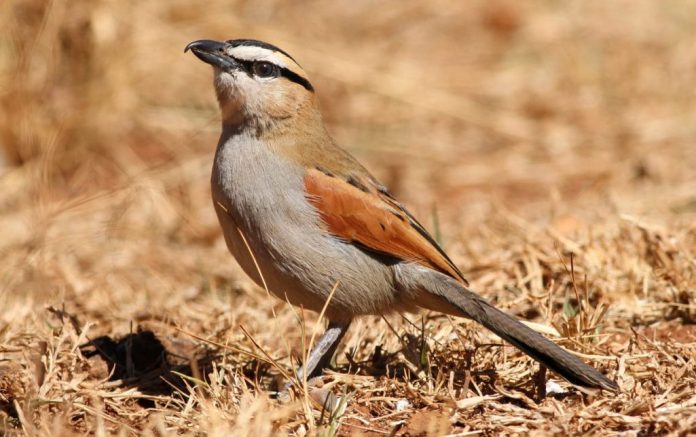Description: The Black-crowned Tchagra (Tchagra senegalus) species are found in the ranges throughout the more humid parts of Africa in scrub, open woodland, semi-desert, and cultivations.
Range: This passerine bird has been recorded in northern Namibia, Botswana, Zimbabwe, the Transvaal, Swaziland, KwaZulu-Natal, and the Eastern Cape Province. The four subspecies in the region appear to have continuous ranges, except for a break of lower reporting rates through the Transvaal, which probably separates T. s. Kalahari in the west from the race Mozambique in the east. Its density has been estimated at 1 pair/25 ha at Nylsvlei, but the size of a breeding territory may be 4 ha.
It is usually encountered in pairs. It remains hidden in the foliage much of the time. It is an extremely vocal bird, and its presence is easily detected by observers who are familiar with its distinctive calls. Confusion with the similar-looking Southern Tchagra “T. tchagra” and the three-streaked Tchagra “T. australis” is possible.
Habitat: It is present in a wide range of scrub and woodland habitats (avoiding the more arid regions with an average annual rainfall below 300 mm) and occurs within exotic timber plantations, but only where dense undergrowth is present. The vegetation analysis shows that, although it is present in most woodland types, it is most common in mesic, broadleaved woodlands such as Miombo and Moist Woodland and is considerably less common in Mopane and Valley Bushveld.
Although a fairly high reporting rate is shown for forest biomes, it is found only in the fringes and surrounding areas rather than in the forest interior. Similarly, it is found only in thickets and patches of alien trees in the grassland biome. It is common in large gardens and parks.

Movements: It is suspected of undertaking some short-range seasonal movements, but the resolution of the atlas data is too coarse to reveal positive evidence of such minor movements. The models show that it was reported more frequently in the summer months, but this may simply indicate that it is more vocal and more conspicuous then. A single ringed adult was recovered within 1 km of the ringing site.
Breeding: The black-crowned Tchagra breeding data indicate a long summer breeding season. The bird normally lays 2 or 3 heavily marked white eggs in a cup nest in a bush or tree. Egg-laying in the Transvaal spans from September until January, with a peak observed in October–December and August–April and an October–November peak in Zimbabwe. The female incubates eggs for 12 to 15 days before hatching, and baby Tchagra fledges after 15 days.
Interspecific Relationships: It is sympatric over a large area with the Three-streaked Tchagra and over a smaller area with the Southern Tchagra. The ecological separation of the three species is unclear, and this species is often encountered in close proximity to, and in the same habitat as, the other two, although the black-crowned Tchagra tends to be restricted to the denser bush.
Distribution and Conservation: The Black-crowned Tchagra is likely to have decreased in areas where intensive agriculture and urbanization have replaced natural vegetation, but its present distribution is not believed to differ significantly from that of the past. The distribution shown in KwaZulu-Natal is very similar to that reported in Cyrus.
Food: The food habits of black-crowned Tchagra are similar to those of other shrikes, often hunting insects and small prey from a perch on a tree or in a bush. Also, the baby bird has a brown cap and a pale yellow bill, and the sexes are similar to other shrikes.
Vocalizations: So, nearly 14 subspecies have been found, different in size and the color of the back, underparts, and eyestripe. This bird has a melodious descending whistling song, chee-chee cheroo cheroo, and can be immediately tempted into sight by imitating this call, apparently because the bird is concerned that there is an intruder in its territory. The male bird also has a switchback display in flight.

Read More: Carolina Wren Call – Songs – Sounds